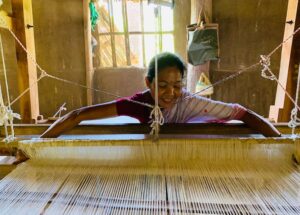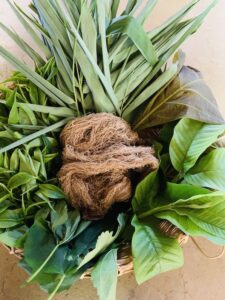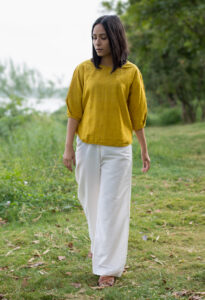Moborr
Less is always more
Who is making the clothes?
 A small but skilled team comprising a supervisor, a pattern maker, a cutter, two tailors, and an an iron person make our clothes. The hangtags are strung and knotted by hand, piece by piece. This is all done in Bengaluru.
A small but skilled team comprising a supervisor, a pattern maker, a cutter, two tailors, and an an iron person make our clothes. The hangtags are strung and knotted by hand, piece by piece. This is all done in Bengaluru.
Our fabrics are sourced directly from weaver communities and a network of NGOs. Since we work with handwoven textiles, the artisan is given enough lead time to craft it at his or her own time.
Life-cycle of products and how environmental concerns are addressed in these
 True to our brand philosophy, we work with homegrown textiles, earth-friendly dyes and natural materials. Our favourite handwoven textiles are organic cottons, naturally coloured cottons and Eri silks. We are inspired and led by the thought of taking India’s rich textile story far and wide, empowering regional communities along the journey, and creating a sustainable wardrobe solution for women across the globe.
True to our brand philosophy, we work with homegrown textiles, earth-friendly dyes and natural materials. Our favourite handwoven textiles are organic cottons, naturally coloured cottons and Eri silks. We are inspired and led by the thought of taking India’s rich textile story far and wide, empowering regional communities along the journey, and creating a sustainable wardrobe solution for women across the globe.
The width of most of our fabrics is around 39â€. The pattern designing happens keeping in mind the fabric width so that there is minimum cutting waste. All offcuts are carefully consolidated. The bigger chunks are used to make sleeves or smaller panels. The rest of them are sorted out colour-wise for future use. None of it goes to landfills. We have devised ways for making waste wearable. Our upcoming collection features artsy, one-of-a kind pieces from the smallest of remnants.

We don’t follow the fashion calendar and instead focus on designing for longevity. Our clothing pieces can be enjoyed for years and even passed down from one generation to the other. At the end of their lives, these can be happily sent for composting. The buttons also get composted and go back to where they belong. We use only coconut-shell buttons and have given up zippers.
We manage our production and inventory tightly. Every style is made in small batches so as to avoid overstocking and then selling on discounts later. We also keep the number of styles produced in check and ensure top-quality craftsmanship. Only when one style goes out of stock is a new design introduced.
We have started taking pre-orders of sold-out styles. This has worked very well in terms of keeping production runs to a minimum and helping us plan exactly how much to procure and how many quantities to make. In the four years of our journey, we have not held any annual sales or deep-discounts schemes.
Our packaging is minimal and plastic-free. All orders are neatly packed in organic cotton or canvas bags. These are hand block-printed with GOTS-certified dyes by young autistic adults. We feel it is important to offer adults on the autism spectrum a chance to show their talents and abilities. We use ecofriendly tapes to seal our packages. There’s no trace of chemicals.
As far as marketing goes, we have no big advertising budgets. All of our clientele is through word of mouth, pop-us, influencers, media features and social media connect. This keeps our costs in check.

Madhurima Tongia, founder, Moborr
Challenges in scaling up sustainable fashion
Sustainability will be a priority for fashion over the next decade as the climate crisis remains top of mind for brands and consumers. Scaling up sustainable fashion might seem like a juxtaposition, but we need to evolve ways to use greener fibres and aim to reduce and repurpose wastage.
Some challenges are:
- Small consumer base
- Consumer demographic
- Cost of production
- Response to trends
- Textile waste and fashion waste
- Quality and quantity
- Time taken in weaving on looms
All the above challenges are also a window to stand out. We as creators are responsible for educating people about the processes used in the creation of a line. This will lead to market expansion and opening up of more opportunities, resulting in more people believing in sustainable life choices and empathising with slow processes that are good for all.
As a business practice, if brands can be close-looped, then scalability will be quite effective. The more a brand wishes to produce, the more waste it has to consolidate. Considering that the fashion industry produces so much waste, upscaling close-looped systems will enable more of these discarded textiles to be put back into the cycle. Reuse of our resources is the strongest option we have to restore the planet.
Also, there should be group systems in every city where discarded fashion can be mended and reused as opposed to buy-and-throw. Donating, sharing wardrobes and a pervasive hand-me-down culture will limit the unnecessary accumulation of waste.
Things consumers should keep in mind
- To begin with, it’s about being aware about consumerism and its associated health risks.
- Making informed decisions regarding clothing is everyone’s responsibility.
- Checking the labels is important. Everyone must do their research.
- Knowledge about handloom versus machine-made textiles is helpful.
- Why slow fashion costs more, and why artisans and staff should be paid living wages.
- Shop less, make it last. Reduce, repurpose and recycle.
Then there is radical thinking. Radical rethinking requires changing the mentality of both consumers and the industry – one where profits are no longer of utmost importance, and other factors like the state of the environment and people’s wellbeing gain primacy. Consumers need to be considerate about their clothes’ longevity, which means they are conscious about the number of clothes they buy and the number of times these are worn before being thrown away.
Awareness involves not only having the information, but also ensuring it is easily understood and accessible by all. Adopting an environmentally friendly laundry regime is an example of how better knowledge can change people’s habits; washing full-loads, using the correct washing cycle, switching to energy-efficient washing machines, washing in cold water, drying clothes on a line, and using biodegradable detergents all add to sustainability.
Sustainability experts are calling on the fashion industry to go beyond harm mitigation and create a positive impact. We want to champion the cause of positive impact. We have recently ventured into regenerative fashion with our Eri silk pieces.
We are on a mission to solve the everyday wardrobe quandary while being a 100% sustainable clothing brand that translates heritage-rich Indian textiles into precious keepsakes that can be worn with pride and style year on year, by women across the globe.
Womenswear: Dresses, tops, blouses, overlays, bottoms
Where available: https://moborr.com
Online marketplace presence in Switzerland and Singapore
Retail presence in Jaipur, Goa and Bengaluru
Click on the pages below to continue reading about the brands.
And here's a checklist for responsible brands.

